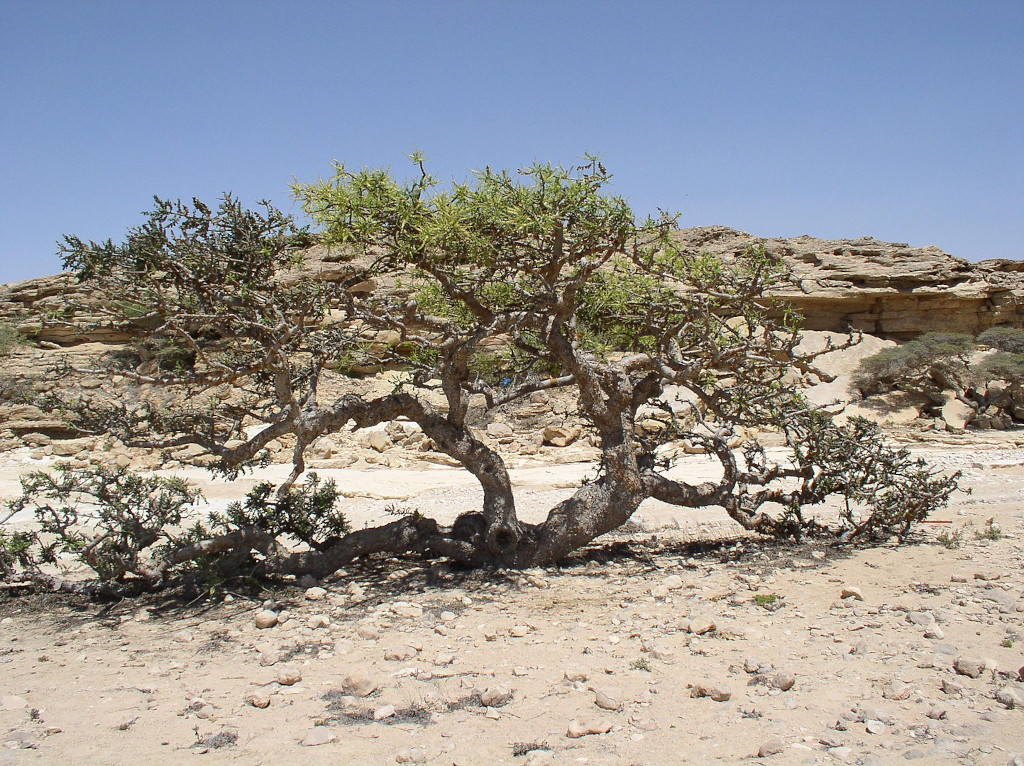
Oman
Frankincense
Boswellia thurifera

General Description/Cultural Significance
Clustered between the United Arab Emirates, Saudi Arabia, and Yemen is Oman, the country with the UNESCO World Heritage Site aptly named “The Land of Frankincense.” Traditionally, frankincense is synonymous with Omani hospitality and is burned as incense when guests arrive in a home and after they are served meals. The citrus and pine-like aroma of frankincense is also thought to protect from evil, cure a variety of ailments such as joint pain, sore throats, indigestion, and is used as a natural deodorant. Frankincense can commonly be found scenting homes, cars, offices, and places of worship throughout Oman. Frankincense has been so highly valued in ancient times that it was worth its weight in gold, and historically Oman has produced the most valuable frankincense, which the Egyptians called the “sweat of the gods.” According to Oman’s Ministry of Tourism, “Frankincense is a symbol of life, or rather it is life itself, for the Dhofari people. It is not a mere tree, but an embodiment of culture, history, sociology and geography.”
Frankincense is harvested from the boswellia sacra tree which grows in Dhofar, the southern province of Oman, where the environment is notoriously inhospitable for most other plants. Hojari frankincense, which is the most highly valued based upon its color, clump size, and oil concentration, can be found in the Dhofar Mountains in the southern tip of the Arabian Peninsula where Oman sits.
Climate Change/Conservation Status
Increased international demand for essential oils and herbal medicines have lead to higher and higher tree cultivation rates, causing the Boswellia sacra tree to be listed as a “Near Threatened” species on the Red List of Threatened Species, and a recent study showed that in the next twenty years frankincense production will decrease by 50% because the trees are dying off so rapidly. Boswellia tree populations in the Jabal Samhan Nature Reserve in Dhofar, Oman have decreased by 85%.
In order to harvest frankincense, incisions are made in the trunk of the tree where the sap leaks out and hardens into a frankincense resin. In order to remain healthy trees are not supposed to be cut more than twelve times in one year. However, with minimal job opportunities, increasing cost of living, and high demand for essential oils, Omani frankincense trees are being cut as many as 120 times to gather resin. In 2018, the essential oil industry was worth $7 billion, a value which is expected to double by 2026 causing even higher demand for frankincense resin and further threatening the longevity of this historical tree and its iconic smell.
Sources
Baker, C., 2022. Oman’s ancient biblical scent. [online] Bbc.com. Available at: <https://www.bbc.com/travel/article/20190813-omans-ancient-biblical-scent> [Accessed 27 July 2022].
Bongers, F., Groenendijk, P., Bekele, T., Birhane, E., Damtew, A., Decuyper, M., Eshete, A., Gezahgne, A., Girma, A., Khamis, M., Lemenih, M., Mengistu, T., Ogbazghi, W., Sass-Klaassen, U., Tadesse, W., Teshome, M., Tolera, M., Sterck, F. and Zuidema, P., 2019. Frankincense in peril. Nature Sustainability, 2(7), pp.602-610.
Fobar, R., 2019. Frankincense Trees – of biblical lore – are being tapped out for essential oils. [online] National Geographic. Available at: https://www.nationalgeographic.com/animals/article/frankincense-trees-declining-overtapping [Accessed 27 July 2022].
Times of Oman. 2022. We Love Oman: The land of frankincense. [online] Available at: https://timesofoman.com/article/92396-we-love-oman-the-land-of-frankincense [Accessed 27 July 2022].
Wiener, J., 2022. Oman: The Land of Frankincense – Tony Walsh. [online] World History Encyclopedia. Available at: https://www.worldhistory.org/article/1329/oman-the-land-of-frankincense—tony-walsh/ [Accessed 27 July 2022].

